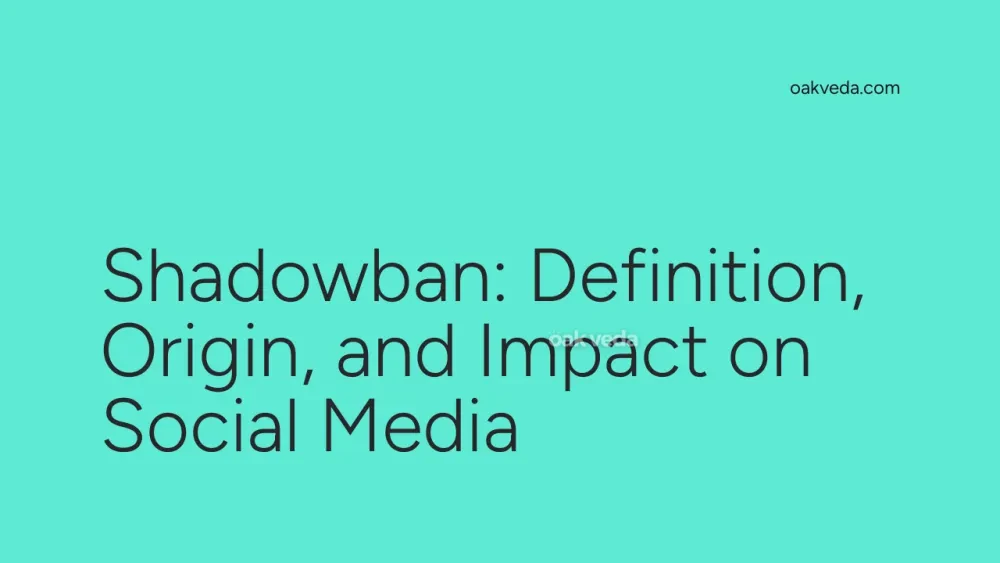
What is Shadowban?
Shadowban, also known as ghost ban or stealth ban, is a practice used by social media platforms to limit the visibility of a user's content without their knowledge. When shadowbanned, a user's posts and interactions become invisible or significantly less visible to other users on the platform, while remaining visible to the user themselves. This covert restriction is designed to curb the spread of inappropriate content, spam, or rule violations without explicitly notifying the affected user.
Origin and Development of Shadowban
The concept of shadowbanning originated in the early days of online forums and message boards as a moderation tool. It gained prominence in the social media era as platforms sought more nuanced ways to manage user behavior and content quality. While the exact timeline is unclear, the term "shadowban" became widely recognized around 2012-2014, coinciding with the rapid growth of platforms like Instagram and Twitter.
How Shadowban Works
Shadowbanning operates through complex algorithms that flag potentially problematic content or user behavior. When a user is shadowbanned:
- Their posts don't appear in hashtag searches
- Their content is deprioritized in followers' feeds
- Their account becomes harder to find in search results
- Interactions with their content are limited
The key characteristic of a shadowban is its opacity – users aren't notified of the restriction, making it challenging to identify and address the issue.
Types of Shadowbans
While the term "shadowban" is often used broadly, there are several variations:
- Hashtag shadowban: Content doesn't appear in hashtag searches
- Account shadowban: The entire account's visibility is reduced
- Partial shadowban: Only certain types of content (e.g., stories, reels) are affected
- Temporary shadowban: Restrictions are lifted after a set period
Popular Examples of Shadowban
Shadowbanning has been reported across various social media platforms:
- Instagram: Users have reported their posts not appearing in hashtag searches or the Explore page
- Twitter: Some users have noticed reduced engagement and visibility in search results
- TikTok: Creators have experienced sudden drops in video views and engagement
- YouTube: Content creators have reported their videos not appearing in recommended feeds
While platforms rarely confirm the existence of shadowbans, these experiences have led to widespread discussions and concerns among users.
Impact of Shadowban on Social Media Culture
Shadowbanning has significantly influenced social media culture:
- Increased anxiety: Users constantly worry about inadvertently triggering a shadowban
- Self-censorship: Fear of shadowbans leads some users to be overly cautious with their content
- Transparency concerns: The lack of clear communication about shadowbans has eroded trust in platforms
- Algorithmic awareness: Users have become more conscious of how their actions affect content visibility
Controversies Surrounding Shadowban
The practice of shadowbanning has sparked several controversies:
- Lack of transparency: Platforms often deny the existence of shadowbans, leading to user frustration
- Bias allegations: Some users claim shadowbans disproportionately affect certain groups or viewpoints
- Free speech concerns: Critics argue that shadowbanning is a form of censorship
- Inconsistent application: The seemingly arbitrary nature of shadowbans has led to accusations of unfair treatment
How Brands and Influencers Navigate Shadowbans
For brands and influencers, shadowbans can be particularly damaging. To mitigate risks and maintain visibility, they often:
- Diversify content across multiple platforms
- Engage authentically with their audience to boost organic reach
- Use a mix of popular and niche hashtags
- Avoid spammy behavior like excessive posting or using banned hashtags
- Regularly audit their account's performance to detect potential shadowbans early
Future Trends Related to Shadowban
As social media evolves, we can expect several trends related to shadowbanning:
- Increased transparency: Platforms may provide more clarity on content moderation practices
- AI-powered moderation: More sophisticated algorithms could lead to more nuanced content restrictions
- User controls: Platforms might offer users more control over their content's visibility
- Regulatory scrutiny: Governments may step in to regulate content moderation practices, including shadowbanning
FAQs about Shadowban
-
How can I tell if I'm shadowbanned? Monitor your engagement rates, ask followers if they can see your content, and check if your posts appear in hashtag searches while logged out.
-
How long does a shadowban last? Duration varies, but most shadowbans are temporary, lasting from a few days to a few weeks.
-
Can I appeal a shadowban? Most platforms don't officially acknowledge shadowbans, making appeals difficult. However, you can try contacting support if you believe your account has been unfairly restricted.
-
Do shadowbans affect all social media platforms? While the term is widely used, each platform has its own content moderation practices. What's called a "shadowban" may vary across different social networks.
-
How can I prevent being shadowbanned? Follow platform guidelines, avoid spammy behavior, use hashtags responsibly, and engage authentically with your audience.
Understanding shadowbans is crucial for anyone looking to maintain a strong social media presence. By staying informed about platform policies and best practices, users can navigate the complex world of content visibility and continue to reach their audience effectively.
You may be interested in:
- CTA: Definition, Origin, and Impact in Social Media Marketing
- Influencer Marketing Management: Definition, Origin, and Impact
- Opp: Definition, Origin, and Impact in Social Media
- Lowkey: Definition, Origin, and Impact on Social Media
- Caught in 4K: Definition, Origin, and Impact on Social Media
- B2C: Definition, Origin, and Impact on Social Media Marketing

